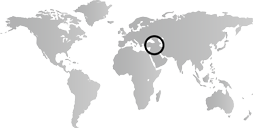In the course of World War I, the Ottoman empire is occupied and dismantled by European forces. Each of its provinces is divided among the winning powers in the war (Britain, France, Italy, and Russia) and the mainland of Anatolia becomes a contested territory among foreign powers. After a nine-month fight for independence led by Mustafa Kemal (later named Atatürk, 1881–1938), the Republic of Turkey is declared in 1923.
During the late Ottoman period, the European academic style continues to be the major influence in painting. This is the heyday of painters Osman Hamdi (1842–1910) and Abdülmecid Efendi (1968–1944). The stakes change with the declaration of the Republic. Turkish artists struggle between adapting trends from Europe and creating a national form of art, based in the long-established traditions of their country. Atatürk takes a deep interest, guiding the development of the arts to match his vision of Turkish identity. He supports both the revival of village culture and an interest in Europe, as a sign of modernity. As a result, the modernist movement in architecture strongly influences new design and construction in the capital of Ankara during the 1930s. In the first two decades of the century, Westernizing art is in vogue; academies and societies are founded and group exhibitions are held. The artists associated with this movement, often referred to as the 1914 Generation or the Çallı Group, embrace European-style portraiture and Impressionism. Atatürk’s secular and modernizing policies, particularly the abandonment of the Arabic script in favor of the Latin, have a significant impact on the visual arts.
After World War II, however, Turkey’s ties to Europe weaken. American architecture—especially the skyscraper—and painting come to have a greater influence on the Turkish arts scene. Turkey’s first modern art movement, the D Group, rejects the principles of earlier movements (1914 Generation) in favor of Post-Cubism and Constructivist painting. Founded by Nurullah Berk (1906–1982) and Çemal Tollu (1899–1968), the D Group includes artists such as Elif Naci (1898–1987) and Abidin Dino (1913–1993). During the 1950s and ’60s, Abstract Expressionism and other forms of abstract painting are introduced, as is reflected in the work of Adnan Çoker (born 1927), Turan Erol (born 1927), and Orhan Peker (1927–1978). Contemporary artists living in Turkey today can be seen as members of the current international scene, interested in questions of identity (East/West), gender, heritage (past/present), urban/rural, local/universal, economics and social class, and the supremacy of the corporate economy and global politics. Informed by postmodern notions of fragmentation, hybridity, and social criticism, they work in the media of painting, sculpture, photography, large-scale installation, and video.
Meanwhile, in the Caucasus, nationalist movements arise as the Ottoman and Russian empires begin to collapse in the early twentieth century. Attempts to create independent republics are quashed and lands in this region are absorbed into the Soviet Union. They gain their independence only after the collapse of that state in 1991, and are then divided into the republics of Armenia, Azerbaijan, Georgia, and Russia. During this period, painters are trained in traditional European-style academies, either in Moscow or on the Continent. Martiros Saryan (1880–1972), for example, works in a Post-Impressionistic style and experiments with capturing the essence of light in his landscape and still-life paintings. One of the world-renowned painters to come out these schools is Arshile Gorky (Vosdanik Adoian, 1904–1948), who was born in Armenia and moved to New York in 1925. He is considered a progenitor of Abstract Expressionism, although his later works are profoundly affected by European Surrealism, particularly the work of Joan Miró, André Masson, and Matta. His disciple in Soviet Armenia, Artour Oshakantsi (born 1953), becomes the greatest Armenian painter in the Soviet Union. He is the founder of Abstract Naturalism and is perhaps the most well-known painter of Independent Armenia. In Soviet Armenia, where abstractionism symbolized the voice of social protest, Oshakantsi is one of the first artists to use abstraction to express his political rage. Traditional arts, like carpet weaving and embroidery, are practiced, albeit with lesser intensity and vibrancy, geared toward commercial consumption and export. Contemporary artists from the Caucasus grapple with issues of identity, displacement, homeland, political freedom, national self-assertion, and their new position within the global community.


